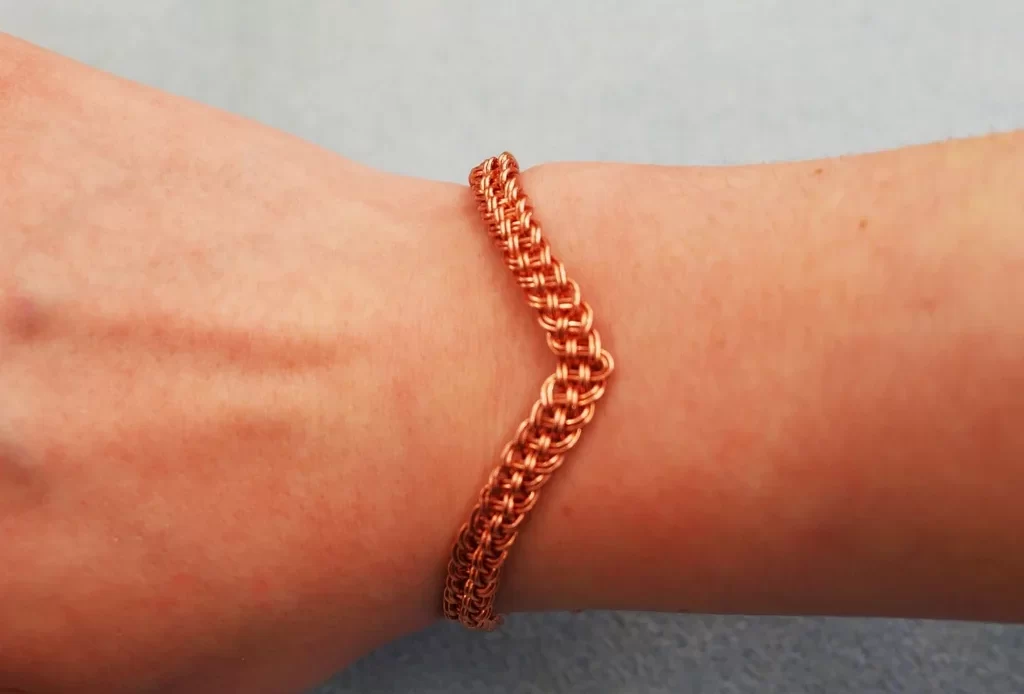
wearing copper bracelets can lead to skin irritation, discoloration, and allergic reactions. When copper comes in contact with your skin, it can leave a green or blue stain on your wrist. Moreover, if you have sensitive skin, you may experience redness, itchiness, and rashes. Therefore, it’s crucial to take precautions before wearing a copper bracelet to avoid any adverse effects.
However, before you ditch your copper bracelets altogether, let’s take a closer look at the potential side effects and how to mitigate them. In this article, we will provide you with valuable information and tips from experts on how to wear copper bracelets safely and effectively. So, if you’re a copper bracelet enthusiast or considering wearing one for health benefits, keep reading to learn more about the side effects of wearing copper bracelets and how to avoid them.
What are copper bracelets?
Copper bracelets are made of copper metal and are worn around the wrist like a bracelet. They have been used for centuries as a form of alternative medicine to alleviate pain and inflammation. The idea is that copper when in contact with the skin, is absorbed into the body and helps with various health problems.
How do copper bracelets work?
The way copper bracelets work is still a mystery to many scientists and researchers. While the scientific community has yet to fully understand how they work, many people swear by their healing properties. Here’s a closer look at how copper bracelets work:
Copper’s Role in the Body
Copper is an essential trace element that plays a key role in many bodily functions. It helps with the formation of red blood cells, supports the immune system, and aids in the production of collagen, a protein that is essential for healthy skin, hair, and nails.
When copper comes into contact with the skin, it is believed to be absorbed into the body through sweat and other bodily fluids. Once inside the body, copper can have a range of positive effects on various bodily systems.
Balancing the Body’s Energy
One of the most commonly cited benefits of copper bracelets is their ability to balance the body’s energy. According to ancient Indian medicine, the body has seven chakras, or energy centers, that must be in balance for optimal health. Copper is believed to help balance the energy in these chakras, which can lead to a wide range of health benefits.
Reducing Inflammation
Copper is also thought to have anti-inflammatory properties, which can help reduce pain and swelling in the body. Inflammation is a natural response to injury or infection, but chronic inflammation can lead to a range of health problems, including arthritis, heart disease, and cancer. By reducing inflammation, copper bracelets may be able to help prevent or alleviate these conditions.
Improving Circulation
Copper is also believed to improve circulation, which can have a range of health benefits. Improved circulation can help deliver oxygen and nutrients to the body’s cells more efficiently, which can boost energy levels and improve overall health.
Additionally, improved circulation can help with the removal of toxins and waste products from the body. This can help reduce the risk of a range of health problems, including chronic fatigue, headaches, and skin problems.
The benefits of wearing copper bracelets
There are various benefits associated with wearing copper bracelets. Some people believe that copper can help with arthritis, joint pain, inflammation, and even headaches. Copper is also believed to have antimicrobial properties that can help fight off bacteria and viruses.
Side effects of wearing copper bracelets
While there are many benefits associated with wearing copper bracelets, there are also side effects that you should be aware of. Here are some of the most common side effects reported by people who wear copper bracelets:
1. Skin irritation
One of the most common side effects of wearing a copper bracelet is skin irritation. Copper can cause a greenish discoloration on the skin, and in some cases, it can lead to itching and rashes. This is because copper is a reactive metal, and it can interact with the oils on your skin, causing a chemical reaction.
If you are prone to skin allergies, it’s best to avoid wearing copper bracelets altogether. If you do decide to wear one, make sure to clean it regularly and avoid wearing it for extended periods.
2. Allergic reactions to metals
Another potential side effect of wearing a copper bracelet is a metal allergy. Copper is one of the most common causes of metal allergies, and if you are allergic to copper, you may experience symptoms such as redness, itching, and swelling.
If you have a history of metal allergies, it’s important to avoid wearing copper bracelets. If you do decide to wear one, make sure to test it out first by wearing it for short periods and monitoring any symptoms.
3. Discoloration of the skin
Wearing a copper bracelet for long periods can cause discoloration of the skin. The discoloration can range from green to black and can be difficult to remove.
4. Interference with medical devices
Copper can interfere with medical devices such as pacemakers and defibrillators. If you have a medical device implanted, you should avoid wearing a copper bracelet.
5. Interaction with medications
Copper can interact with certain medications, such as nonsteroidal anti-inflammatory drugs (NSAIDs), antibiotics, and antacids. If you are taking any medications, it’s best to consult with your doctor before wearing a copper bracelet to avoid any potential interactions.
6. Risk of copper toxicity
Copper toxicity is a rare but potentially serious side effect of wearing a copper bracelet. This occurs when the body absorbs too much copper, which can lead to nausea, vomiting, and even liver damage.
The risk of copper toxicity is higher for people who have a high copper intake from their diet or other sources. If you have liver disease, it’s best to avoid wearing copper bracelets altogether.
How to reduce the side effects of wearing copper bracelets
If you want to wear a copper bracelet but are concerned about the side effects, or if you’re experiencing side effects from wearing a copper bracelet, there are steps you can take to reduce their impact and risk:
1. Choose the Right Type of Copper Bracelet
Not all copper bracelets are created equal. When shopping for a copper bracelet, look for one that is made from pure copper rather than a copper alloy. Pure copper bracelets are less likely to cause skin irritation or discoloration. It’s also important to choose a bracelet that fits comfortably without being too tight or too loose.
2. Take breaks and avoid wearing the bracelet for long periods
Wearing a copper bracelet all day, every day can increase the risk of side effects. Take breaks from wearing your bracelet, especially if you’re experiencing skin irritation or discoloration. Start by wearing it for a few hours a day and gradually increase the amount of time you wear it as your skin adjusts.
Avoid wearing the bracelet for long periods, especially if you are experiencing any side effects. Take if off if you experience copper bracelet side effects and see if they go away.
3. Keep the bracelet clean
Keep the bracelet clean by washing it with soap and water. This will help prevent skin irritation and discoloration.
Gently wash it with mild soap and water and dry it thoroughly after wearing it. Avoid using harsh chemicals or abrasive materials that could damage the bracelet or irritate your skin.
4. Consider a Copper-Plated Bracelet
If you’re still experiencing side effects from wearing a pure copper bracelet, consider switching to a copper-plated bracelet. These bracelets are made from a base metal, such as stainless steel or brass, and then coated with a thin layer of copper. This can provide the benefits of copper while reducing the risk of side effects.
5. Consult with your doctor
If you’re experiencing persistent or severe side effects from wearing a copper bracelet, consult with your doctor. They can help determine if the bracelet is causing the side effects or if there is an underlying medical condition that needs to be addressed. They can also provide guidance on alternative treatments for your condition.
Conclusion
Copper bracelets have been a popular health trend for centuries, but they do come with some side effects. Skin irritation, allergic reactions, discoloration of the skin, and interference with medical devices are some of the most common side effects reported by people who wear copper bracelets. If you want to wear a copper bracelet, choose high
quality copper bracelets made of pure copper, avoid wearing them for long periods, keep them clean, and consult with your doctor if you have any medical conditions or are taking medication.
RELATED:
- Who Should Not Wear Tiger Eye Stone? Know the Limitations and Side Effects
- Black Onyx Stone Side Effects: Myths and Facts
- Who Should Not Wear Amethyst Stone?
FAQs
Are copper bracelets safe to wear?
While copper bracelets are generally safe to wear, they can cause skin irritation, allergic reactions, discoloration of the skin, and interference with medical devices. If you experience any side effects, it’s best to take a break from wearing the bracelet and consult with your doctor.
Can copper bracelets help with arthritis?
There is no scientific evidence to support the claim that copper bracelets can help with arthritis. However, some people have reported relief from joint pain and inflammation when wearing copper bracelets.
How do I clean my copper bracelet?
You can clean your copper bracelet by washing it with soap and water. You can also use a soft cloth to polish the bracelet.
How long can I wear a copper bracelet?
It’s best to avoid wearing a copper bracelet for long periods, especially if you are experiencing any side effects. Take a break from wearing the bracelet and see if the side effects go away.
Can copper bracelets interfere with medical devices?
Copper can interfere with medical devices such as pacemakers and defibrillators. If you have a medical device implanted, you should avoid wearing a copper bracelet.

